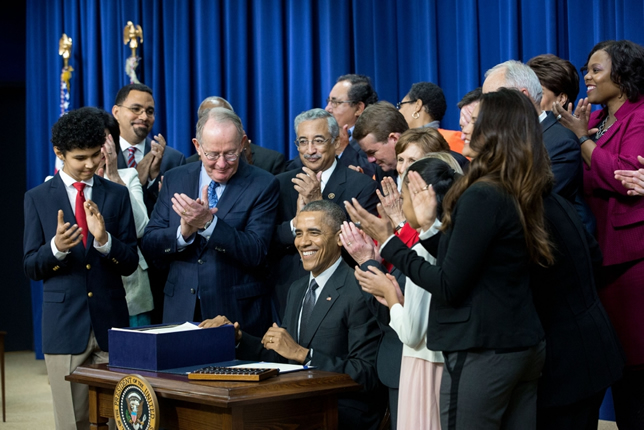ESSA Signing a 'Christmas Miracle' for States
- By Dian Schaffhauser
- 12/11/15
President Obama's signature has made it official: No Child Left Behind (NCLB) has been replaced with the Every Student Succeeds Act (ESSA) as the country's national education law. Flanked by students, teachers, United States Department of Education representatives and a bipartisan group of Congressional members, Obama sealed the deal on months' worth of wrangling to shift much of the heavy lifting for K-12 education decision-making over to the states.
The new legislation was passed by the U.S. House of Representatives in early December, approved by the U.S. Senate days later and made it to the president's desk in time to beat the formal retirement from public service of out-going Education Secretary Arne Duncan.

White House photo by Amanda Lucidon
Calling the bipartisan bill signing a "Christmas miracle," Obama noted that while NCLB had the "right" goals, it often fell short in practice. "It didn't always consider the specific needs of each community. It led to too much testing during classroom time. It often forced schools and school districts into cookie-cutter reforms that didn't always produce the kinds of results that we wanted to see."
It hasn't all been failure, he noted. Over the past seven years of his administration, states have pushed to raise the academic expectations of their students, graduation rates have risen, dropout rates have shrunk and more students are attending and graduating from college "than ever before."
ESSA builds on those reforms, Obama insisted, by "holding everybody to high standards for teaching and learning, empowering states and school districts to develop their own strategies for improvement, dedicating resources to our most vulnerable children."
When the new act goes into effect, annual testing in math, language arts and science will still be required, at least in grades 3-8 and once in high school, and results will have to be publicly reported; but what happens with those results after that is left up to the states to determine.
Also, the bill requires states to intervene in the bottom 5 percent of their schools, and in high schools failing to graduate a third or more of their students or where specific groups of students consistently underperform. But states will be in charge of figuring out how to identify low performers and working with those districts to develop intervention and improvement plans.
The populist cry of "too much testing" from right and left influenced those aspects of the education legislation. As Obama explained, ESSA encourages states and districts to "reduce unnecessary standardized tests" while also making sure parents and teachers get "clear information" about their children's academic performance.
Primarily, however, the fierce federal funding high stakes directed at seeing improvements in student scores have been defanged. And states must take up the vigil to ensure their own standards of learning and assessment by setting long-term student achievement goals with measurements of interim progress.
The act also expands access to high-quality preschools and creates incentives for innovative approaches to learning and for supporting great teachers.
Technology and innovation in instructional practice receives a lot of attention in ESSA through grants that support "the effective use of technology," push professional development of educators, experiment with blended and personalized learning, boost STEM efforts and promote the availability of digital learning opportunities in rural and other under-served areas.
The bill's many provisions promoting the use of technology in education received the support of the State Education Technology Directors Association (SETDA). In a statement Interim Executive Director Lan Neugent said the organization's members "are looking forward to providing their expertise as state and local education leaders work to include technology in their plans to increase academic achievement and ensure that every student does succeed."
Teaching Matters, a nonprofit that works with educators in urban public schools to improve their instructional practices, was "pleased" to see the focus on teacher development. "Professional development should be 'sustained, intensive, collaborative, job-embedded, data-driven, classroom focused...'" the organization said in a prepared statement. "These are key elements of how Teaching Matters supports educators to lead their own learning communities, and such collaboration really moves the needle for kids."
The International Association for K-12 Online Learning (iNACOL) favored the law's focus on "new, personalized learning models." In a prepared statement President and CEO Susan Patrick and Vice President for Federal and State Policy Maria Worthen called the commitment to equity for all students a "sea change." "We are moving from an old era of data poverty to an era of multiple measures to evaluate student success. This will provide a catalyst to examine what it means for each and every child to be prepared with a quality education and engage as thoughtful citizens successful in their communities for the future."
Alliance for Excellent Education, a national group working on federal education policy, commented on the compromise aspects of ESSA. "While Republicans celebrated the transfer of authority from the federal government to states, Democrats focused on changes to the bill made in the conference committee that restored protections for low-performing schools and students," the nonprofit observed. Comparing NCLB to a "DVD in a Netflix world," Alliance President Bob Wise noted that he was "pleased that [ESSA] keeps the nation's foot on the high school graduation rate pedal while also providing states and districts with a great deal of flexibility and responsibility."
Keeping the education vehicle moving forward while returning the job of navigation back to more local decision-makers is ultimately what's needed, the president observed just before he signed the bill into law. "We need to build on the momentum that has already been established. We've got to learn what works and do more of that, and we've got to get rid of the stuff that doesn't work. And that's exactly what the Every Student Succeeds Act does."